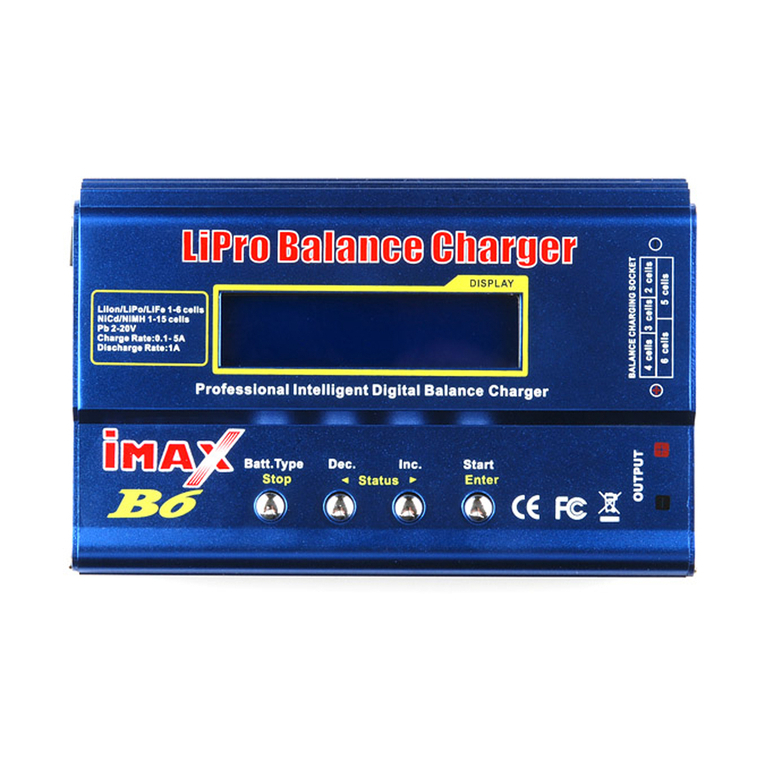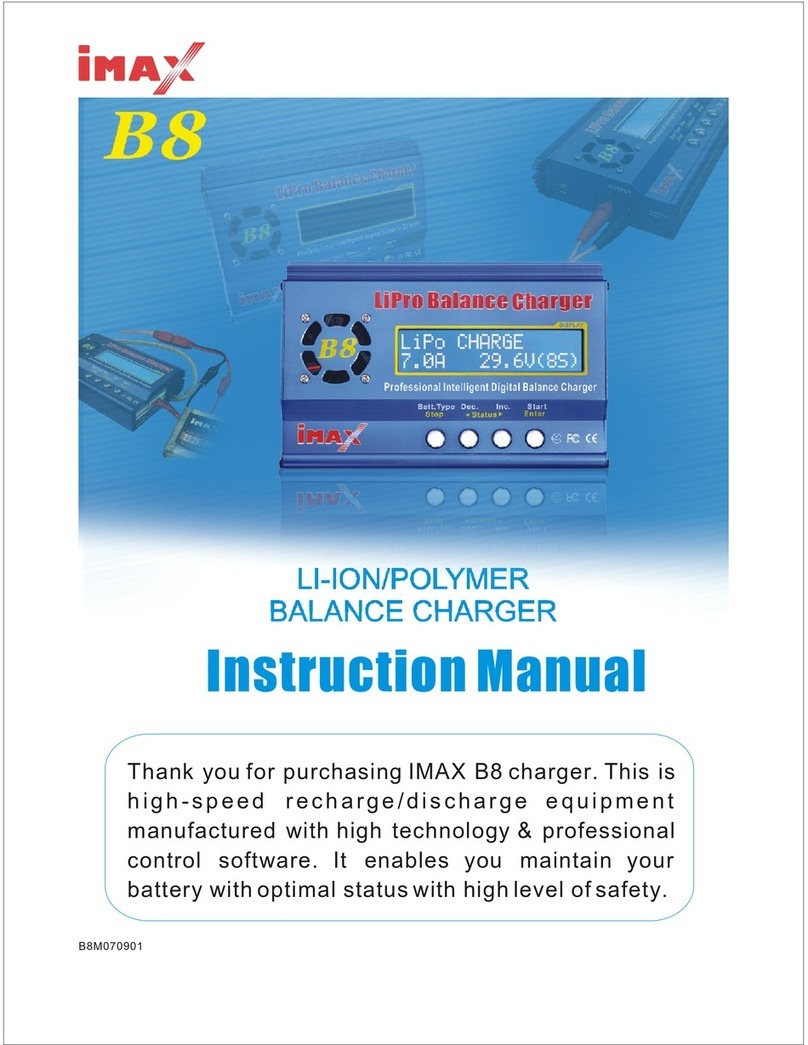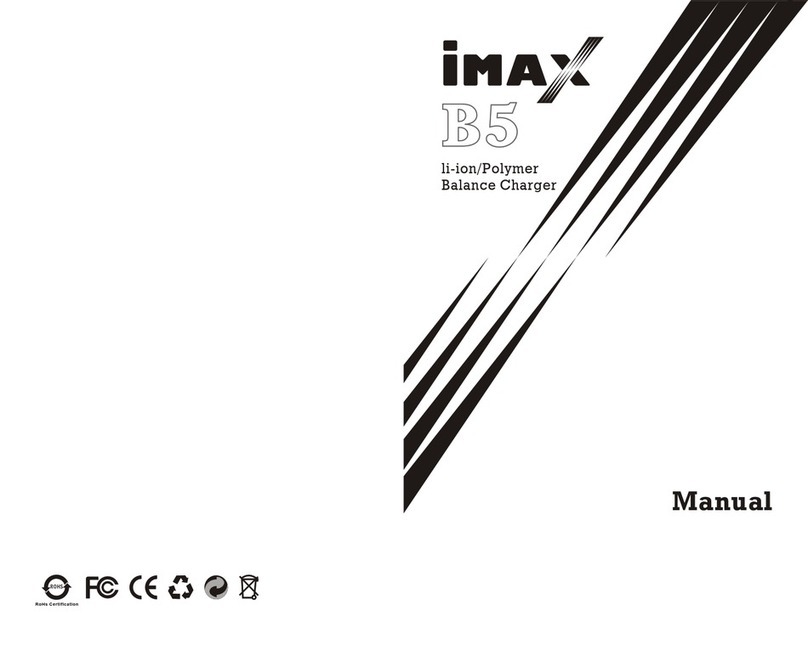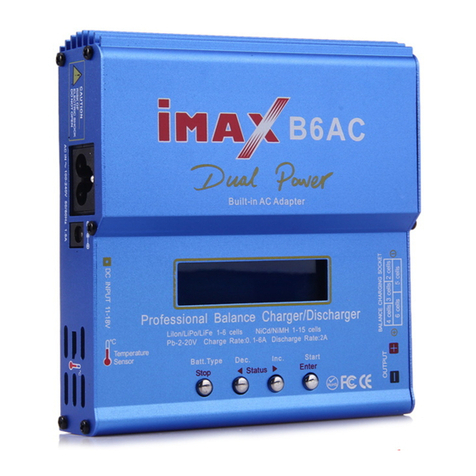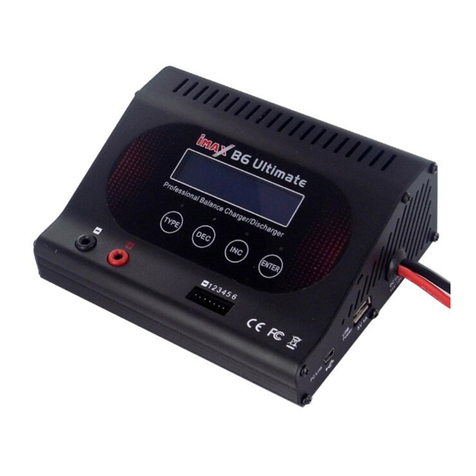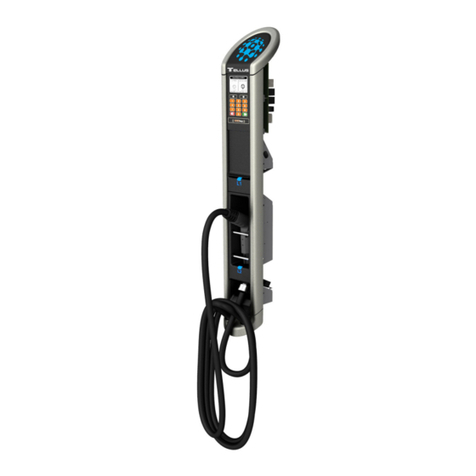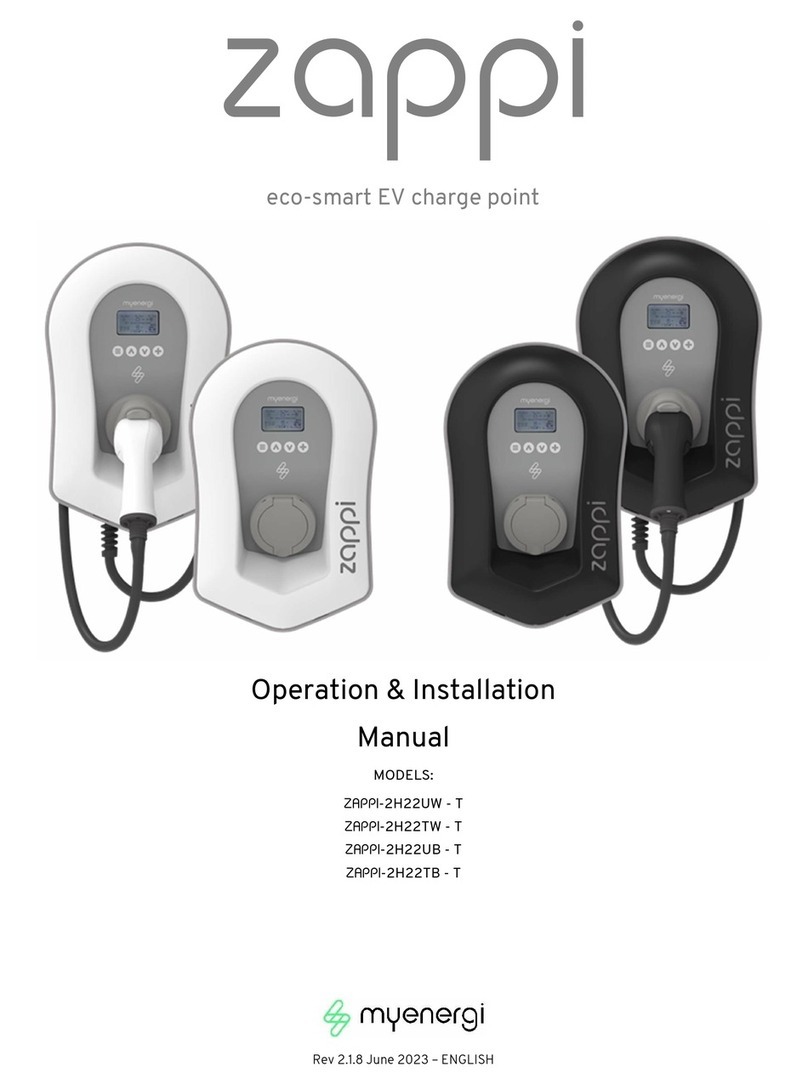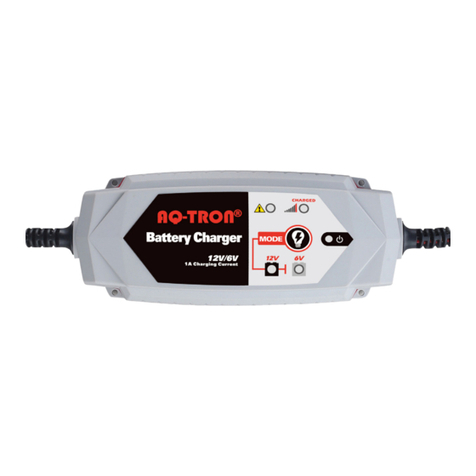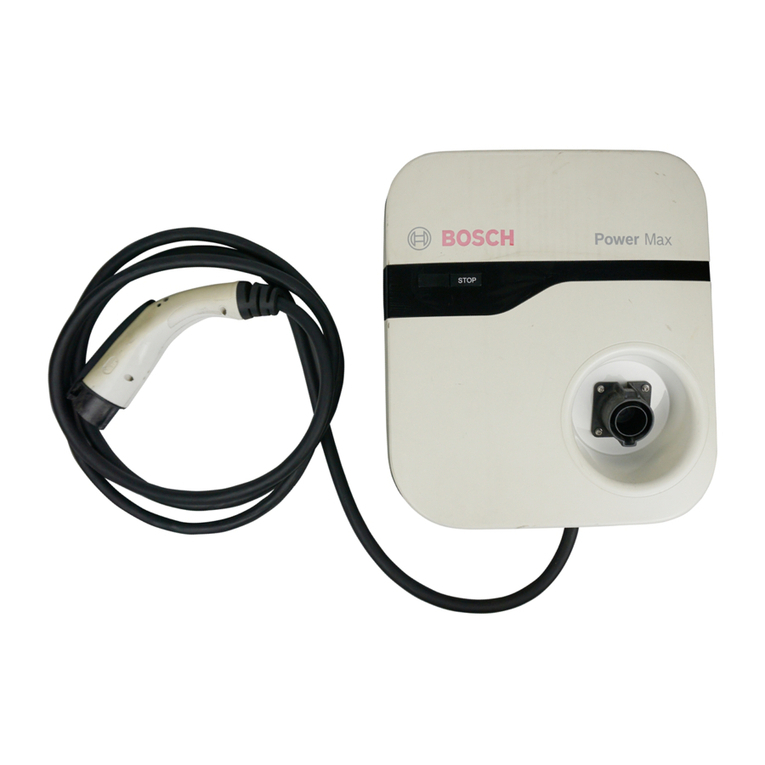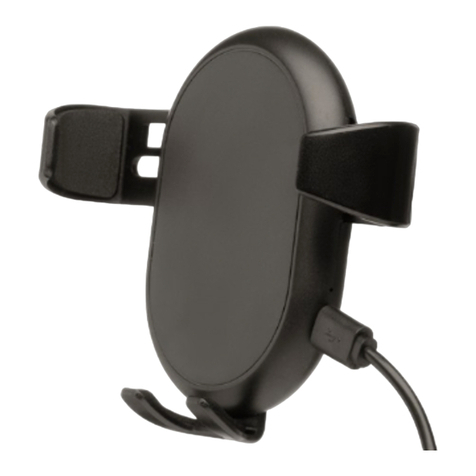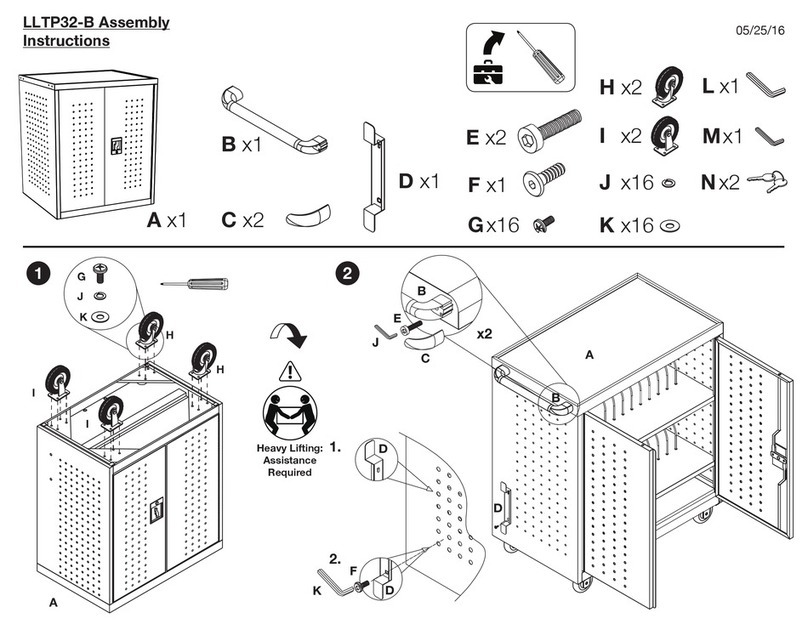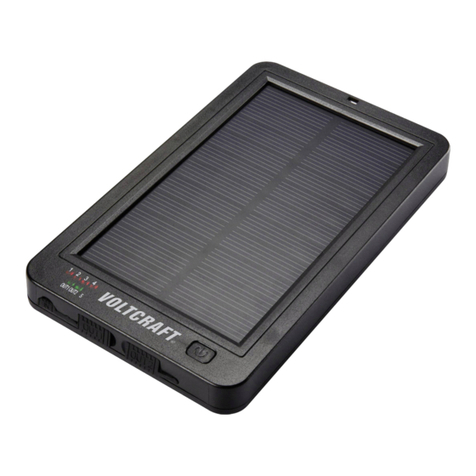Imax B6 Ultimate User manual

Instruction Manual

Thank you for purchasing the B6 LiPro Balance Charger by iMAX.This
product is a rapid charger with a high performance microprocessor and
specialized operating software. Please read this entire operating manual
completely and attentively before using this product, as it covers a wide
range of information on operating and safety. Orplease do usethis product
in company witha specialist!
INTRODUCTION
Specifications
Operating voltage range:
Circuit power:
Charge current range:
Discharge current range:
Current drain forbalancing Li-po:
NiCd/NiMH battery cellcount:
li-ion/Polymer cell count:
Pb battery voltage:
Weight:
Dimensions:
DC11.0~18.0 Volt
AC100-240V,50/60Hz
Max. charge power50W
Max. discharge power5W
0.1~5.0A
0.1-1.0A
300mAh/cell
1~15cell
1-6 series
2V, 20V
580g
133 87 33mm
Optimized operating software
B6 features the so-called AUTO function that set the feeding current
during the process of charging or discharging. Especially for Lithium
batteries, it can prevent the overcharging which may lead to an explosion
due to the user's fault. It can disconnect the circuit automatically and
alarm once detecting any malfunction. All the programs of this product
were controlled through two way linkage and communication, to achieve
the maximum safety and minimize the trouble. All the settings can be
configured by users!
SPECIAL FEATURES
Internal independent Lithium battery balancer
B6 employs an individual-cell-voltage balancer. It isn’t necessary to
connect an externalbalancer for balancecharging.
Balancing individual cells battery discharging
During the process of discharging, B6 can monitor and balance each cell
of the battery individually. Error message will be indicated and the
process will beended automatically if the voltage of any single onecell is
abnormal.

Adaptable to various type ofLithium battery
B6 is adaptable to various types of Lithium batteries, such as Li-ion, LiPo
and the newLiFe series ofbatteries.
Fast and storage modeof Lithium battery
Purposes to charge Lithium battery varies, ‘fast’ charge reduce the
duration of charging, whereas ‘store’ state can control the final voltage
of your battery, so as to store for a long time and protect useful time of the
battery.
Maximum safety
Delta-peak sensitivity: The automatic charge termination program based
on the principle of the Delta-peak voltage detection. When the battery's
voltage exceeds the threshold, the process will be terminated
automatically.
Automatic charging current limit
You can set upthe upper limit of the charging current when charging your
NiCd or NiMHbattery; it is useful for theNiMH battery of low impedance
and capacity inthe 'AUTO' chargingmode.
Temperature Threshold*
The battery’s internal chemical reaction will cause the temperature of the
battery to rise. If the temperature limit is reached, the process will be
terminated.
* This function is available by connecting optional temperature probe,
which is notincluded in our package.
Processing time limit:
You can also limitthe maximum processtime to avoid any possible
defect.
Input power Monitoring
To protect the car battery used as DC input power from being damaged, its
voltage keeps being monitored. If it drops below the lower limit, the
process will beended automatically.
Capacity limit
The charging capacity is always calculated as the charging current
multiplied by time. If the charging capacity exceeds the limit, the process
will be terminatedautomatically when you set the maximumvalue.
Data store/load
The maximum five batteries’data can be stored for users’convenience.
You can keep the data pertaining to program setting of the battery of
continuous charging or discharging. Users can call out these data at any
time without anyspecial program setting.

Cyclic charging/discharging
1 to 5 cyclic and continuous process of charge>discharge or
discharge>charge is operable for battery refreshing and Balancing to
stimulate the battery’s activity.
Analysis is available in PCthrough USB communication **
For technical specialist, B6 offers PC-based software which can analyze
the characteristic of the battery via USB port. A graph of voltage, current,
capacity and temperature curves, and voltage of individual battery of the
battery pack willbe displayed.
**
This function is available bypurchasing optional software, which isnot included
in our package.

.Scroll through theMain Menu
.Stop any chargeprocesses
Alter values
cells in balancecharge mode
See the statusof individual
LCD screen
Balance lead sockets
JST-XH ports
Input power cable
11-18V DC
Output charge lead
4mm banana plug
.Resume or startcharge processes
.Confirm an action

Failure to connect as shown in this diagram will damage this charger.
This diagram shows the correct way to connect your battery to the B6
charger while charging in the balance charge program mode only.
WARNING:
The main battery leads must be connected along with the balance lead connector
as shown before charging your battery ..
If using crocodile clips as shown in above diagram, make sure they are
unable to touch together!
WARNING:
LITHIUM POLYMER BALANCE CHARGE PROGRAM
CONNECTION DIAGRAM

These warnings andsafety notes are particularly important.
Please follow theinstructions for maximum safety;
otherwise the chargerand the battery can be damaged
or at worstit can cause a fire.
Never leave the charger unattended when it is connected to its
power supply. If any malfunction is found, TERMINATE THE
PROCESS AT ONCE and refer to theoperation manual.
Keep the chargerwell away fromdust, damp, rain,heat, direct
sunshine and vibration.Never drop it.
The allowable inputvoltage is 11-18V DC
This charger and the battery should be put on a heat-resistant,
noninflammable and nonconductive surface. Never place them on
a car seat, carpet or similar. Keep all the inflammable volatile
materials away fromoperating area.
Make sure you know the specifications of the battery to be
charged or discharged to ensure it meets the requirements of this
charger. If the program is set up incorrectly, the battery and
charger may be damaged .It can cause fire or explosion due to
overcharging. This warranty is not valid for any damage or
subsequent damage arising as a result of a misuse or failure to
observe the proceduresoutlined in this manual.
NiCd/NiMH
Voltage level:1.2V/cell
Allowable fastcharge current: 1C-2C (depends on the
performance of cell)
Discharge voltage cutoff level: 0.85V/cell(NiCd), 1.0V/cell(NiMH)
Li-ion Voltagelevel: 3.6V/cell
Max. charge voltage:4.1V/cell
Allowable fastcharge current: 1C or less
Min. discharge voltagecut off level:2.5V/cell or higher
LiPo Voltagelevel: 3.7V/cell
Max. charge voltage:4.2V/cell
Allowable fastcharge current: 1C or less
Discharge voltage cutoff level: 3.0V/cellor higher
LiFe Voltagelevel: 3.3V/cell
Max. charge voltage:3.6V/cell
Allowable fastcharge current: 4C or less
Discharge voltage cutoff level: 2.0V/cellor higher
Pb Voltagelevel: 2.0V/cell
(Lead-acid) Max. chargevoltage: 2.46V/cell
Allowable fastcharge current: 0.4C or less
Discharge voltage cutoff level: 1.75V/cellor higher
.........
WARNING AND SAFETY NOTES

To avoidshort circuit betweenthe charge lead always connect the
charge cable tothe charger first, then connect thebattery. Reverse
the sequence whendisconnecting.
Do not connectmore than one battery pack tothis charger at
any one time.
Never attempt tocharge or discharge the following typesof
batteries.
“A battery pack which consists of different types of cells
(including different manufacturers)
“A battery that is already fully charged or just slightly
discharged.
“Non-rechargeable batteries (Explosionhazard).
“Batteries that require a different charge technique from
NiCd, NiMh, LiPoor Gel cell (Pb, Lead acid).
“A faulty or damaged battery.
“A battery fitted with an integral charge circuit or a
protection circuit.
“Batteries installed in a device or which are electrically
linked to othercomponents.
“Batteries that are not expressly stated by the
manufacturer to be suitable for the currents the charger
delivers during thecharge process.
Please bear inmind the following points before commencing
charging:
“Did you select the appropriate program suitable for the type of
battery you are charging?
“Did you setup adequate current for charging ordischarging?
“Have you checked the battery voltage? Lithium battery packs
can be wired in parallel and in series, i.e. a 2 cell pack can be
3.7V (in parallel)or 7.4V (in series).
“Have you checked that all connections are firm and secure?
Make sure there are no intermittent contacts at any point in the
circuit.
“

Charging
During charge process, a specific quantity of electrical energy is fed into the
battery. The charge quantity is calculated by multiplying charge current by
charge time. The maximum permissible charge current varies depending on the
battery type or its performance, and can be found in the information by the
battery manufacturer. Only batteries that are expressly stated to be capable of
quick-charge are allowed to be charged at rates higher than the standard
charge current.
Connect the battery to the terminal of the charger: red is positive and black is
negative. Due to the difference between resistance of cable and connector, the
charger can not detect resistance of the battery pack, the essential requirement
for the charger to work properly is that the charge lead should be of adequate
conductor cross-section, and high quality connectors which are normally gold-
plated should befitted to both ends
Always refer to the manual by the battery manufacturer pertaining to charging
methods, recommended charging current and charging time. Especially, the
Lithium battery should be charged according the charging instruction provided
by the manufacturerstrictly.
Attention should bepaid to the connection of Lithium battery especially.
Do not attemptto disassemble the battery pack arbitrarily
Please get highlighted that Lithium battery packs can be wired in parallel and in
series. In the parallel connection, the battery’s capacity is calculated by
multiplying single battery’s capacity by the number of cells with total voltage
stay the same. The voltage’s imbalance may cause fire or explosion .Lithium
battery is recommendedto charge in series.
Discharging
The main purpose of discharging is to clean residual capacity of the battery, or
to reduce the battery’ voltage to a defined level. The same attention should be
paid to the discharging process as charging. The final discharge voltage should
be set up correctly to avoid deep-discharging. Lithium battery can not be
discharged to lower than the minimum voltage, or it will cause a rapid loss of
capacity or a total failure. Generally, Lithium battery doesn’t need to be
discharged. Please pay attention to the minimum voltage of Lithium battery to
protect the battery.
Some rechargeable batteries have a memory effect. If they are partly used and
recharged before the whole charge is accomplished, they remember this and
will only use that part of their capacity next time. This is a ‘memory effect’ It is
said that NiCd and NiMH batteries are suffering from memory effect. NiCd has
more memory effectthan NiMH.
Lithium batteries are recommended to be discharged partially rather than fully
discharged. Frequent full discharging should be avoided if possible. Instead,
charge the batterymore often or use a battery of larger capacity.
Full capacity cannot be used until it has been subjected to 10 or more charge
cycles. The cyclic process of charge and discharge will optimize the capacity of
battery pack.

LiXX Charge
Program Select
Lithium Battery
LiXX
Fast Charge
LiXX Balance
NiMH Charge
‘Aut/Man’
Program Select
NiMH Battery
NiMH
Cycle
NiMH
Discharge
LiXX
Storage
LiXX
Discharge
NiCd Charge
‘Aut/Man’
Program Select
NiCd Battery
NiCd
Cycle
NiCd
Discharge
Pb Charge
Program Select
Pb Battery
Pb
Discharge
Save Data
Program Select
Save Data
Capacity
Cut-off
Safety Timer Key Beep
Buzzer
TempCut-off
USB Enable
Chg>Dchg
Waster Time
NiCd D.Peak
Sensitivity
User Set
Program
LiPo/Lilo/LiFe
Chk Time
LiXX V.Type NiCd D.Peak
Sensitivity
LoadData
Program Select
Load Data
Input Power Low
Cut-off
Bat. Type
Stop
Bat. Type
Stop
Bat. Type
Stop
Bat. Type
Stop
Bat. Type
Stop
Bat. Type
Stop
Start
Enter
Start
Enter
Start
Enter
Start
Enter
Start
Enter
Start
Enter
Start
Enter
Start
Enter
Program flow chart

To avoid from erroneous setting by
users,B6 detects the cell count of Lithium
battery automatically at the beginning of
charge or discharge process. But battery
that is deep-discharged can't be detected
correctly. To avoid this error, the time term
can be set to verify the cell count by the
processor. Normally, 15 seconds are
enough to detect the cell count correctly.
You need to extend the time term limit for
the battery of large capacity. But the
charge or discharge process may come to
an end within the time term because of the
time limit decided by the wrong count if
you set too long time limit for the battery of
small capacity. This may cause fatal error.
You have to extend the time term if the
processor detect the cell count incorrectly
at the beginning of charge or discharge
process. Otherwise, default value is
recommended to use.
This shows the trigger voltage for
automatical charge termination of NiMH
and NiCd battery. The valid value ranges
from 5 to 20 mV per cell. Setting the
trigger voltage higher brings a danger of
overcharging; whereas setting it lower
brings a possibility of premature
termination. Please refer to the technical
specification of the battery.(NiCd
default:12mV, NiMH default:7mV)
LiFe
V.Type 3.3V
LiFe
V.Type 3.3V
LiPo/LiIo/LiFe
CHK Time 10 min
NiMH Sensitivity
D.Peak Default
NiCd Sensitivity
D.Peak Default
NiCd Sensitivity
D.Peak Default
NiCd Sensitivity
D.Peak Default
LiFe
V.Type 3.3V
LiFe
V.Type 3.3V
LiPo/LiIo/LiFe
CHK Time 10 min
NiMH Sensitivity
D.Peak Default
NiCd Sensitivity
D.Peak Default
USB/Temp Select
Temp Cut-Off 80C
USB/Temp Select
USB Enabled
INC
INC
INC
INC
INC
INC
INC
INC
INCINC
DEC
DEC
DEC
DEC
DEC
DEC
DEC
DEC
DECDEC
-
-
-
-
--
+
+
+
+
++
As default this charger will be set to typical user settings when it is
connected to a 12V battery for the first time. The screen displays the
following information in sequence and the user can change the
parameter on eachscreen.
If you need to alter the parameter value in the program, press
Start/Enter key to make it blink then change the value with INC
or DEC key. The value will be stored bypressing Start/Enter key
once.
The screen shows the nominal voltage of
Lithium battery. There are three kinds of
Lithium battery: LiFe(3.3V), Lilo(3.6V) or
LiPo(3.7V). This information is of critical
importance that you have to check the
battery carefully to make sure it is set up
correctly. If it is different from correct
value, explosion can occur during charge
process.

There is a 3-pin port on the left of the charger used as USB interface or
temperature sensor port. If the screen displays temperature, you can use
the optional temperature probe to connect to the surface of the battery. If it
is set as the USB port, you can connect the charger to your PC through the
optional USB cable to monitor the charging process through optional
software.
The maximum temperature of the battery can be set during the charge
process. The process will be terminated automatically to protect battery
once the temperature of battery reaches this value. This feature is
accomplished through temperatureprobe (optional).
INC
INC
INC
INC
INC
INC
INC
INC
INC
INC
INC
INC
INC
DEC
DEC
DEC
DEC
DEC
DEC
DEC
DEC
DEC
DEC
DEC
DEC
DEC
-
-
-
-
-
-
-
-
+
+
+
+
+
+
+
+
LiFe
V.Type 3.3V
LiFe
V.Type 3.3V
LiFe
V.Type 3.3V
LiFe
V.Type 3.3V
LiFe
V.Type 3.3V
Waste time
CHG/DCHG 5min
Key Beep ON
Buzzer ON
Input power low
Cut-Off 10.0V
Capacity Cut-Off
ON 5000mAh
Safety timer
ON 120min
The battery becomes warm after
cycles of charge/discharge process.
The program will insert a time delay
after each charge/discharge process
to allow the battery enough time to
cool down before beginning next
cycle of charge/discharge process.
The valid value ranges from 1 to 60
minutes.
When the charge process starts, the
integrated safety timer starts to run
simultaneously. If error detected or
the termination circuit can not detect
whether the batteryis fully charged or
not, this unit is programmed to
prevent overcharging. Please refer to
the below statement to calculate the
timer you set.
The program provides maximum
capacity protection function. If the
Delta-peak voltage can not be
detected or thesafety timer times out,
the charge process will stop
automatically, when the battery
reaches the user-set maximum
charge capacity,
The beep to confirm users' operation
sounds every time a button is
pressed. The beep or melody sounds
at various times during operation to
confirm different mode change.
These functions can be switched on
or off.
This function monitors the voltage of
the input battery used to power this
charger. If the voltage is lower than
user-set value, the program will end
forcibly to protectthe input battery.

NiMH Sensitivity
D.Peak Default
NiMH Sensitivity
D.Peak Default
NiMH Sensitivity
D.Peak Default
LiPo BALANCE
2.0A 11.1V(3S)
Li3s 1.2A 12.59V
BAL 022:43 00682
R:3SER S:3SER
CONFIRM(ENTER)
INC
INC DEC
DEC -
-+
+
Start
Enter
Batt type
Stop ‘>3 seconds’
Charged
capacity
Number
of
cells
Charging
time
Charging
current
Battery
voltage
Start
Enter
The program is only suitable for charging/discharging Lithium-polymer
batteries with a nominal voltage of 3.3/3.6/3.7V/cell. Different batteries
have different charge technique. There are two methods termed as
constant voltage and constant current. The charge current varies
according to battery capacity and specification. The final voltage is very
important; it should precisely match the voltage of the battery: LiPo is 3.6V,
LiLo is 4.1V and LiFe is 3.6V. The current and voltage of the battery should
be correctly set.
When you want to change the values of parameters, please press
START/ENTER key to make it blink and then use DES or INC to change the
value. Then pressSTART/ENTER key again tostore the value.
The left side of the first line shows
the type of battery you choose.
The value on the left of the second
line of the charger is current user
set, After setting the current and
voltage, press START/ENTER key
for more than 3 seconds to start
the process.(charge current: 0.1-
5.0A, voltage: 1-5V).
This displays the number of cells
you set up and the processor
detects. “R” shows the number of
cells detected by the charger and
“S” is the number of cells set by
you at the previous screen. If both
numbers are identical you can
start charging by press
START/ENTER button. If not,
press BATT TYPE/STOP button to
go back to previous screen to
carefully check the number of cells
of the battery pack before going
ahead.
When charging NiCd or NiMH batteries, divide the capacity by current,
then divide the result by 11.9, set this number of minutes as the value for
safety timer setting. If the charger stopped at this time threshold, about
140% of thecapacity will have been fed into the battery.
For example:
Capacity Current Safety Time
2000mAh 2.0A (2000/2.0=1000)/11.9=84 minutes
3300mAh 3.0A (3300/3.0=1100)/11.9=92 minutes
1000mAh 1.2A (1000/1.2=833)/11.9=70 minutes
Safe timer Calculation
Lithium Lilo/LiPo/LiFe program
Charging of Lithium battery

NiCd Sensitivity
D.Peak Default
NiCd Sensitivity
D.Peak Default
LiPo FAST CHG
2.0A 11.1V(3S)
Li3S 2.0A 12.59V
FAS 022:43 00682
INCINC DECDEC
--++
Start
Enter
Start
Enter
Batt type
Stop ‘>3 seconds’
Current
voltage
battery
Suppiled
capacity
Charge
current
Charging
time
Number
of
cells
This screen shows the real-time status during charge process. Press
BATT TYPE/STOP keyonce to stop the charge process.
This function is for balancing the voltage of Lithium-polymer battery cells
while charging. In the balance mode, the battery needs to have a balance
lead to connect to the individual port at the right side of the charger. And
you need toconnect the battery's output plug tothe output of charger.
Charging in this mode is different from the normal modes, because the
built-in processor monitors voltage of individual cell and control input
current fed intoeach cell to normalize the voltage.
The value on the left side of the
second lines sets the charge
current. The value on the right
side of the second lines sets the
battery pack's voltage. After
setting current and voltage,
press STAR/ENTER for more
than 3 seconds to start the
process.
This displays the number of cells
you set up and the processor
detects. “R” shows the number of
cells detected by the charger and
“S” is the number of cells set by
you at the previous screen. If
both numbers are identical you
can start charging by press
START/ENTER button. If not,
press BATT TYPE/STOP button
to go back to previous screen to
carefully check the number of
cells of the battery pack before
going ahead.
This screen shows the real-time
status during charge process.
Press BATT TYPE/STOP key
once to stopthe charge process.
Charging lithium battery inthe balance mode
R:3SER S:3SER
CONFIRM(ENTER)
+
+
LiPo 6S
-+
-
+
-
+
-
+
LiPo 5S
+3S
-
+Individual
bal.port
Individual
bal.port
LiPo 4S
-
1cell
2cell
3cell
4cell
5cell
6cell
1cell
2cell
3cell
4cell
5cell
6cell
++
2S
LiPo 3S
+
-
--
LiPo 2S
-
+1S
Top View
Top View
+-
LiPo 1S
-
-
Individual Cell Connection Diagram(pin-assignment of 8-pin)

Number
of
cells
Number
of
cells
DEC
DEC
LiPo STORAGE
2.0A 11.1V(3S)
LiPo FAST CHG
2.0A 11.1V(3S)
Li3S 2.0A 12.59V
STO 022:43 00682
Li3S 2.0A 12.59V
FAS 022:43 00682
-
-
Batt type
Stop
Batt type
Stop
Elapsed
time
Elapsed
time
INC
INC
+
+
Charge
or discharge
current
Charge
current
Supplied
capacity
Supplied
capacity
DEC
DEC
Start
Enter
Start
Enter
-
-
‘>3 seconds’
‘>3 seconds’
INC
INC
+
+
Current
voltage
battery
Current
voltage
battery
Storage control ofLithium battery
This function is for charging/discharging batteries which are not used at
once. This program is designed for charging or discharging of batteries of
specific original state. They are classified by types: 3.75V Lilo, 3.85V LiPo
and 3.3V LiFe. The program will begin to discharge if the original state of
the battery exceedsthe voltage level of storage.
At this screen, you can set up
the current and voltage of the
battery pack. Charging and
discharging will make the
batteries come to the voltage
level of “storage”state.
This screen shows the real-
time status charging. Press
BATT TYPE/STOP key once to
stop the chargeprocess.
Charging current will become lower
when it progress to the end of
charging. A specific CV process will
be reduced to end the charging
process earlier. In fact, the charging
current will goes to 1/5 when the
charging process comes to 1/10.
Charging capacity will be a little
smaller than normal charging, but
charging time will be shortened
accordingly.
You can set up the charging current
and voltage of the battery pack.
Press START/ENTER key to display
voltage confirmation. Then press
START/ENTER key again to confirm
and begin tocharge.
This screen shows the real-time
status of “fast charging”. Press
BATT TYPE/STOP key once to stop
the charge process.
Fast charging of Lithium battery

Number
of
cells
DEC
NiCd Sensitivity
D.Peak Default
LiPo DISCHARGE
1.0A 11.1V(3S)
Li3S 0.4A 12.59V
DSC 022:43 00682
-
Batt type
Stop
elapsed
time
INC
+
discharge
current
Battery
voltage
DEC
Start
Enter
-
‘>3 seconds’
INC
+
Discharged
capacity
Discharging of Lithiumbattery
The value of discharge current
on the left can not exceed 1C,
and the value on the right can
not be under the voltage
recommended by the
manufacturer to avoid deep
discharging. Press
START/ENTER for more than
3 seconds tostart charging.
This shows the real-time
status of discharging, you can
press BATT TYPE/STOP key
to stop discharging.
The processor monitors voltage of each cell when the battery packs are
during its “storage” and “discharging” process. To achieve this feature,
plug each battery to the charger individually. If voltage of any cell is
abnormal, B6 will show error message and terminate the program forcibly.
So if there is battery damage or disconnection, you can see the error
message and pressINC to know which cell isdamaged.
BATTERY VOL ERR
CELL LOW VOL
4.14 4.16 4.09
2.18 0.00 0.00
INC
The processor detects voltage
of one cellis too low.
The 4th cell was damaged. The
value of voltage may be zero if
disconnection occurs.
Voltage balancing and monito ring in the dis charge
process

Battery
type
DEC
NiCd Sensitivity
D.Peak Default
NIMH CHARGE Aut
CUR LIMIT 5.0A
NIMH 2.0A 7.42V
CHG 022:45 00890
-
Batt type
Stop
Elapsed
time
INC
+
Charge
current
Battery
voltage
DEC
Start
Enter
-
‘>3 seconds’
INC
+
Charged
capacity
This program is for charging
and discharging of NiCd/NiMH
batteries associated with R/C
models applications. You can
press START/ENTER key to
make it blink and then INC or
DEC to change the parameter
value. Press START/ENTER
key to storethe value.
This program charge the
battery using the current you
set up. In the “auto” state, you
should set up the upper limit of
the charge current to avoid
damage by excessive feeding
current. Some batteries of low
resistance and capacity can
lead to higher current in the
“auto” charging mode. But in
the manual mode, it will charge
with the current you set. You
can make it blink in the current
field and press INC and DEC at
the same timeto switch mode.
Discharge
current
The screen indicates the
discharging state. You can
press START/ENTER key to
alter discharge current. Press
START/ENTER again to store
the value. Press BATT
TYPE/STOP key to stop
discharging. The emitted
sound alerts the end of
discharging.
Battery
type
Battery
voltage
Elapsed
time
Discharged
capacity
NIMH 1.0A 7.42V
DSC 022:45 00890
Batt type
Stop Start
Enter ‘>3 seconds’
DEC INC DEC INC
Set charge current on the left
and the final voltage on the
right. Range of the charge
current is 0.1-1.0A; range of
final voltage is0.1-25.0V. Press
START/ENTER key for more
than 3 seconds to start the
program.
Set charge current on the left
and the final voltage on the
right. Range of the charge
current is 0.1-1.0A; range of
final voltage is0.1-25.0V. Press
START/ENTER key for more
than 3 seconds to start the
program.
The screen shows the real-time status. Press BATT TYPE/STOP key
to end the program. The sound will emitted to indicates the end of
program.
-+-+
Discharge of NiCd/NiMH battery
Charging of NiCd/NiMH battery
NIMH DISCHARGE
1.0A 11.5V

Battery
type
DEC
NiCd Sensitivity
D.Peak Default
NiCd Sensitivity
D.Peak Default
NIMH CYCLE
DCHG>CHG 3
DCHG 1 1314mAh
CHG 1 1430mAh
NIMH 1.0A 7.42V
D>C 022:45 00890
-
Batt type
Stop
Elapsed
time
INC
+
Discharge
or charge
current
Battery
voltage
DEC
Start
Enter
-
‘>3 seconds’
INC
+
Discharged
or charged
capacity
You can set up sequence on the
left and the number of cycles on
the right. You can balance, refresh
and break-in the battery with this
function .You can set a temporary
cool-off procedure in the user's
setting. Range of the cycle number
is 1-5.
Press BATT TYPE/STOP key to
stop program, you can press
START/ENTER key to alter charge
current. The sound indicates the
end of program.
When it approaches to the end,
you can see the capacity of the
battery being charged or
discharged. You can press INC or
DEC key to display result of each
cycle.
This program is only suitable for charging Pb lead-acid battery with
nominal voltage from 2 to 20V. Pb lead-acid battery is completely
different from NiCd/NiMH battery. These batteries can only deliver current
lower in comparison to their capacity. The same restriction applies to the
charging process. Consequently, the optimum charge current can only be
1/10 of the capacity. Pb battery can not be used for fast-charging, please
follow the instructionsprovided by the battery manufacturer.
You can press START/ENTER key to make it blink and alter the value of
parameters using INC or DEC key, press START/ENTER key to store the
value.
Pb lead-sulphuric acid battery program
Charge/discharge and discharge/charge cycle of
NiCd/NiMH battery

Battery
type
DEC
Pb CHARGE
4.0A 12.0V(6P)
Pb-6 4.0A 12.59V
CHG 022:43 00682
-
Batt type
Stop
Elapsed
time
INC
+
Charge
current
Battery
voltage
DEC
Start
Enter
-
‘>3 seconds’
INC
+
Charged
capacity
Battery
type
DEC
Pb DISCHARGE
1.0A 12.0V(6P)
Pb-6 0.4A 12.59V
DSC 022:43 00682
-
Batt type
Stop
Elapsed
time
INC
+
Discharge
current
Battery
voltage
DEC
Start
Enter
-
‘>3 seconds’
INC
+
Discharged
capacity
Set up the charge current on
the left and nominal voltage on
the right. Range of current is
0.1-5.0A, the voltage should
match the battery being
charged. Press
START/ENTER key for more
than 3 seconds to start
charging.
Set up the charge current on
the left and nominal voltage
on the right. Range of
discharge current is 0.1-
5.0A, the voltage should
match the battery being
charged. Press
START/ENTER key for more
than 3 seconds to start
charging.
The screen displays the
real-time discharging status.
Press START/ENTER key to
alter discharge current.
Press START/ENTER key
again to store the parameter
value you set. Press BATT
TYPE/STOP key to end the
program.
The screen displays the real-
time discharging status. Press
START/ENTER key to alter
discharge current. Press
START/ENTER key again to
store the parameter value you
set. Press BATT TYPE/STOP
key to endthe program.
Charging of the Pb battery
Discharging of t he Pb batteryy

Voltage
DEC
DEC
PROGRAM SELECT
SAVE DATA
SAVE [01] NiMH
14.4V 3000mAh
NiMH CHARGE At*
CUR LIMIT 5.0A
NiMH DICHARGE *
1.0A 11.0V
NiMH CYCLE *
DCHG>CHG 3
Save
Data
number
INC
INC
Capacity
DEC
DEC
DEC
DEC
DEC
-
-
-
-
-
INC
INC
INC
INC
INC
+
+
+
+
+
Type of
battery
Start
Enter
Start
Enter
Start
Enter ‘>3seconds’
‘>3seconds’
Batt type
stop
Set up the charge/ discharge
sequence and cyclenumber.
Set up the discharge current
and final voltage.
Set up the charge current in
the manual mode, or current
limit in the auto mode. Press
INC and DEC key
simultaneously to make the
current field blink to switch
the charge mode.
Setting of the parameter in
the screen will not affect the
charge and discharge
process. They just present
the specification of the
battery. The example is NiMH
battery pack, including 12
cells, the capacity is 3000m
Ah.
For your convenience,B6 has a data storage and load program. It can store
five battery data representing the respective specifications of batteries.
You can call back the data when charging or discharging without setting up
the program again. Press START/ENTER key to make it blink, and use INC
or DEC toset up the parameter.
Data storage program
Saving the data
Other manuals for B6 Ultimate
1
Table of contents
Other Imax Batteries Charger manuals
Popular Batteries Charger manuals by other brands
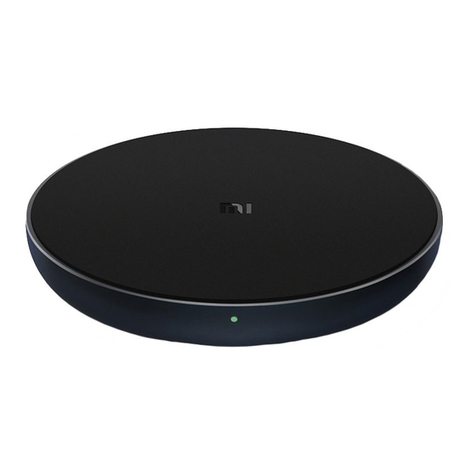
Xiaomi
Xiaomi Mi Wireless Charging Pad WPC01ZM user manual

Orbis
Orbis VIARIS COMBI instructions

ETM MARINE TEC
ETM MARINE TEC ETM-Energy LMC10A user manual

Zero Motorcycles
Zero Motorcycles CHARGE TANK user guide
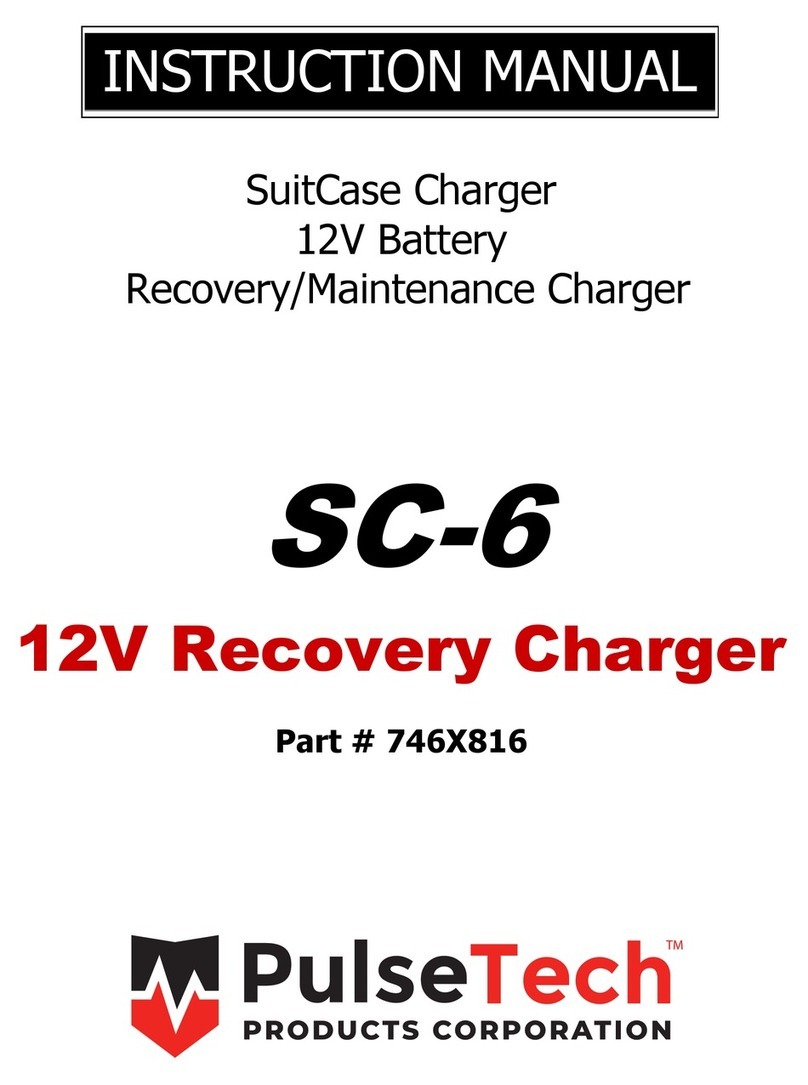
PulseTech
PulseTech 746X816 instruction manual
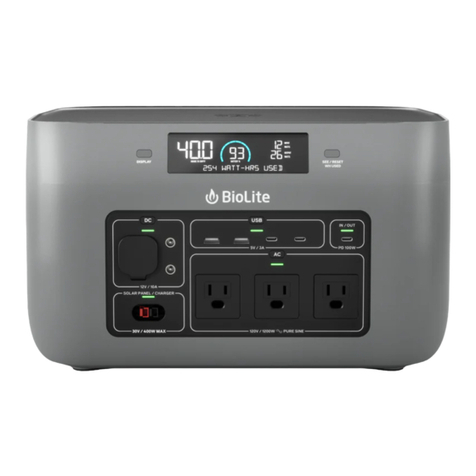
BioLite
BioLite BaseCharge 1500 Instructional manual

